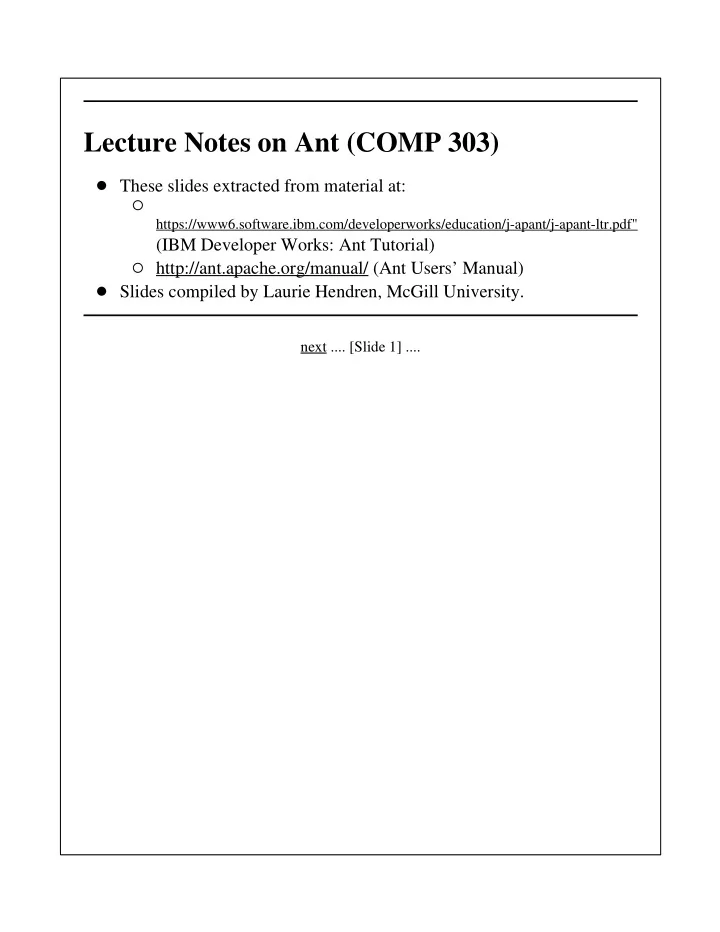

Lecture Notes on Ant (COMP 303) These slides extracted from material at: https://www6.software.ibm.com/developerworks/education/j-apant/j-apant-ltr.pdf" (IBM Developer Works: Ant Tutorial) http://ant.apache.org/manual/ (Ant Users’ Manual) Slides compiled by Laurie Hendren, McGill University. next .... [Slide 1] ....
Ant is a Java-based build tool Original author, James Duncan, called it Another Neat Tool Helps automate the build process. Has many built-in tasks (javac, javadoc, junit, ....) Also allows you to define custom tasks. Allows you to define dependencies between tasks. Has won numerous awards. Has become the de facto standard for building open source Java projects. previous | start | next .... [Slide 2] ....
Ant basics Ant uses build specification files written in XML. There are a defined set of XML elements that Ant understands. Ant can be extended. The default build file is called build.xml . One runs ant using the command: ant (uses the default build.xml file, executes the default target in that file) ant targetname (build.xml, specific target) ant -buildfile buildfilename targetname (use a different build file, specific target) previous | start | next .... [Slide 3] ....
A minimal build.xml file <?xml version="1.0"?> <project default="init"> <target name="init"> <target/> <project/> Must have a default target. Default target must be defined. Could also say <target name="init"/> previous | start | next .... [Slide 4] ....
Can add descriptions and comments <xml version="1.0"?> <project default="init" name="Project Argon"> <description> A simple project introducing the use of descriptive tags in Ant build files. <description/> <!-- XML comments can also be used --> <target name="init" description="Initialize Argon database"> <-- perform initialization steps here --> <target/> <project/> previous | start | next .... [Slide 5] ....
Can define properties <property name="database-file" location="archive/databases/${metal}.db"/> <property name="database-file" location="archive\databases\${metal}.db"/> Can use either kind of path separators, will work on both DOS/Windows and unix systems. Try to avoid DOS drive names "C:/" , not portable. Use relative pathnames when possible. previous | start | next .... [Slide 6] ....
Can define dependencies <target name="init"/> ... <target name="preprocess" depends="init"/> ... <target name="compile" depends="init,preprocess"/> ... <target name="package" depends="compile"/> User can ask to start at any task target. ant compile will run init and preprocess if not already run, and then compile. previous | start | next .... [Slide 7] ....
Let’s look at a complete example Using the money example from the Junit Samples directory. build.xml src/ money/ IMoney.java Money.java MoneyBag.java MoneyTest.java classes/ lib/ doc/ compiled classes to go in classes/ directory generated .jar files to go in lib/ directory generated javadoc html to go in doc/ directory previous | start .... [Slide 8] ....
Recommend
More recommend